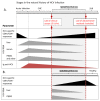Occult Infection with Hepatitis C Virus: Looking for Clear-Cut Boundaries and Methodological Consensus
- PMID: 34945170
- PMCID: PMC8707082
- DOI: 10.3390/jcm10245874
Occult Infection with Hepatitis C Virus: Looking for Clear-Cut Boundaries and Methodological Consensus
Abstract
The sustained virologic response and elimination of HCV is widely viewed as a true cure of chronic hepatitis C as it associates with amelioration of histological liver damage and improved clinical outcomes. Therefore, the existence and clinical burden of occult HCV infection (OCI) has been a controversial issue for many years. In this review, we summarize recently published data that adds new information on the molecular and clinical background of OCI and its epidemiological significance. We also identify and discuss the most important methodological pitfalls, which can be a source of inconsistency between studies. Data that have accumulated so far, strongly support the existence of extrahepatic HCV replication in individuals negative for serum HCV-RNA by conventional clinical tests. OCI emerges as a condition where the immune system is unable to fully resolve infection but it is continuously stimulated by low levels of HCV antigens, leading to progression of liver pathology and extrahepatic HCV-related complications. Moreover, the development of monitoring strategies or management guidelines for OCI is still hampered by the lack of clear definition and the confusion regarding its clinical significance. Careful study design and the introduction of uniform protocols for the detection of low-level HCV-RNA are crucial for obtaining reliable data on OCI.
Keywords: HCV-RNA detection; extrahepatic complications; lymphotropism; occult hepatitis C infection; viral persistence.
Conflict of interest statement
The authors declare no conflict of interest.
Figures

Similar articles
-
Detection of residual HCV-RNA in patients who have achieved sustained virological response is associated with persistent histological abnormality.EBioMedicine. 2019 Aug;46:227-235. doi: 10.1016/j.ebiom.2019.07.043. Epub 2019 Jul 23. EBioMedicine. 2019. PMID: 31345785 Free PMC article.
-
Occult hepatitis C virus infection and its relevance in clinical practice.J Clin Exp Hepatol. 2011 Dec;1(3):185-9. doi: 10.1016/S0973-6883(11)60130-8. Epub 2012 Jan 2. J Clin Exp Hepatol. 2011. PMID: 25755384 Free PMC article.
-
Seronegative occult hepatitis C virus infection: clinical implications.J Clin Virol. 2014 Nov;61(3):315-20. doi: 10.1016/j.jcv.2014.09.007. Epub 2014 Sep 28. J Clin Virol. 2014. PMID: 25304062 Review.
-
Occult Hepatitis C Virus Infection: A Review.J Clin Transl Hepatol. 2018 Jun 28;6(2):155-160. doi: 10.14218/JCTH.2017.00053. Epub 2018 Feb 14. J Clin Transl Hepatol. 2018. PMID: 29951360 Free PMC article. Review.
-
Occurrence of occult HCV infection among Hiv infected patients in Georgia.Georgian Med News. 2014 Jan;(226):37-41. Georgian Med News. 2014. PMID: 24523330
Cited by
-
Hepatitis C Virus Infection Cycle-Specific MicroRNA Profiling Reveals Stage-Specific miR-4423-3p Targets RIG-I to Facilitate Infection.Front Cell Infect Microbiol. 2022 Mar 24;12:851917. doi: 10.3389/fcimb.2022.851917. eCollection 2022. Front Cell Infect Microbiol. 2022. PMID: 35402303 Free PMC article.
-
Assessing Tissue Transmission of Hepatitis C Virus From Viremic Donor to Seronegative Kidney Transplant Recipients: A Case Series.Transpl Int. 2023 Jul 5;36:11110. doi: 10.3389/ti.2023.11110. eCollection 2023. Transpl Int. 2023. PMID: 37534060 Free PMC article.
-
Dysregulation in the microbiota by HBV and HCV infection induces an altered cytokine profile in the pathobiome of infection.Braz J Infect Dis. 2025 Jan-Feb;29(1):104468. doi: 10.1016/j.bjid.2024.104468. Epub 2024 Nov 28. Braz J Infect Dis. 2025. PMID: 39608222 Free PMC article. Review.
-
Prevalence of occult hepatitis C virus infection (OCI) among hemodialysis patients; a cross-sectional study from Lorestan Province, Western Iran.Virusdisease. 2024 Sep;35(3):478-483. doi: 10.1007/s13337-024-00881-y. Epub 2024 Aug 24. Virusdisease. 2024. PMID: 39464727
-
Prevalence and Risk Factors of Occult HCV Infection in the Adult Population of Mexico City.Viruses. 2025 Feb 8;17(2):236. doi: 10.3390/v17020236. Viruses. 2025. PMID: 40006991 Free PMC article.
References
-
- World Health Organization . Recommendations and Guidance on Hepatitis C Virus Self-Testing. World Health Organization; Geneva, Switzerland: 2021. p. 32. - PubMed
-
- Castillo I., Pardo M., Salas C., Graus J., Carreño V., Bartolomé J., Ortiz-Movilla N., Rodríguez-Iñigo E., De Lucas S., Jiménez-Heffernan J.A., et al. Occult Hepatitis C Virus Infection in Patients in Whom the Etiology of Persistently Abnormal Results of Liver-Function Tests Is Unknown. J. Infect. Dis. 2004;189:7–14. doi: 10.1086/380202. - DOI - PubMed
Publication types
LinkOut - more resources
Full Text Sources

